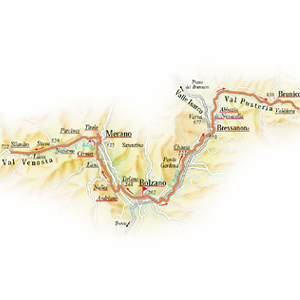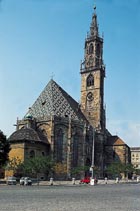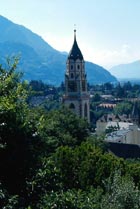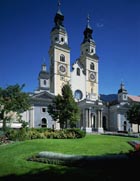The Great Wines of Alto Adige valleys
 The itinerary that takes in discovering the wines of Alto Adige is in two sections. The first runs west from Bolzano, capital of South Tyrol and economic hub of the entire neighbouring region, to Merano and then the Venosta valley. The second runs the other way, eastwards along the Isarco valley as far as the Pusteria valley. The road out of Bolzano to the north east leads directly to the Isarco valley, where the lowest pergola-trained rows of vines benefit from the waters of the eponymous river that has its origins in the heights of the Brenner pass; there are few built-up areas and houses are scattered thinly around the country. The destination is the splendid town of Bressanone, and nearby Varna, where the imposing abbey of Novacella can be found in the centre of a magnificent amphitheatre of vines.
The itinerary that takes in discovering the wines of Alto Adige is in two sections. The first runs west from Bolzano, capital of South Tyrol and economic hub of the entire neighbouring region, to Merano and then the Venosta valley. The second runs the other way, eastwards along the Isarco valley as far as the Pusteria valley. The road out of Bolzano to the north east leads directly to the Isarco valley, where the lowest pergola-trained rows of vines benefit from the waters of the eponymous river that has its origins in the heights of the Brenner pass; there are few built-up areas and houses are scattered thinly around the country. The destination is the splendid town of Bressanone, and nearby Varna, where the imposing abbey of Novacella can be found in the centre of a magnificent amphitheatre of vines.

Bolzano
 Bolzano, the capital of Alto Adige, a city profoundly influenced by all things Germanic from the 12th c. onwards, retaining much typically German architecture, is situated in a wide sunny plain not far upstream from the confluence of the Isarco river with the Adige river at the cross-roads of important natural routes leading to Austria and the plain. The resort was first recorded by Paolo Diacono under the name of Castrum Bauzanum and contains some areas where prehistoric settlements have been found. The cultivation of vines also started in ancient times, producing highly regarded wines like the white wine from the Isarco valley and the Bolzano reds (Colli di Bolzano and Santa Maddalena). The peaks of the Dolomites are in the background.
Bolzano, the capital of Alto Adige, a city profoundly influenced by all things Germanic from the 12th c. onwards, retaining much typically German architecture, is situated in a wide sunny plain not far upstream from the confluence of the Isarco river with the Adige river at the cross-roads of important natural routes leading to Austria and the plain. The resort was first recorded by Paolo Diacono under the name of Castrum Bauzanum and contains some areas where prehistoric settlements have been found. The cultivation of vines also started in ancient times, producing highly regarded wines like the white wine from the Isarco valley and the Bolzano reds (Colli di Bolzano and Santa Maddalena). The peaks of the Dolomites are in the background.
The cathedral, built in the Gothic style in the 14th–15th c., is easily recognisable by its steeply sloping roof with coloured tiles and the perforated cusp on its bell tower; the structure is decorated with portals and reliefs. The inside of the church was seriously damaged by bombing during World War II but a grandiose restoration has been carried out. Its 14th–15th c. frescoes are still visible and both the magnificent baroque altar and the pulpit from 1514 can be admired. Not far from there, are the Chiesa dei Domenicani (Dominican church) and the Chiesa dei Francescani (Franciscan Church); the first was erected at the end of the 13th c. in the German Gothic style and retains important fresco cycles by 14th c. Venetian and Emilian painters of the School of Giotto in the chapels of San Giovanni and Santa Caterina; the second, founded in 1221 and altered in the first half of the 14th c., has a beautiful cloister with trilobed arches resting on small columns with remains of 14th c. frescoes.
Terlano
Her holiday resort, set among vineyards, has given its name to a very stylish D.O.C. white wine. There is an interesting Gothic parish church with a facade decorated with a 15th c. fresco representing Saint Christopher; it has two bell towers, the Romanesque one being incorporated in the building, while the other one, which is separate, was rebuilt in the 19th c. There are 15th c. frescoes inside.
Merano
 The second largest city in the region, after Bolzano, is situated at the confluence of the Passiria and the upper Adige valleys. It used to be called Meirania and was the county capital, ruled by the Counts of Tyrol from the 12th c. onwards. The old heart of the city, on the right of the Passirio river, retains its charming picturesque medieval aspect while more recent residential areas have developed around it, delightfully situated among parks and gardens. The mild climate and the presence of springs of radioactive mineral water have allowed the city to develop as a world class resort and health spa. Fruit and wine production is also important to the economy and the Gran Premio di Merano horse race takes place every year.
The second largest city in the region, after Bolzano, is situated at the confluence of the Passiria and the upper Adige valleys. It used to be called Meirania and was the county capital, ruled by the Counts of Tyrol from the 12th c. onwards. The old heart of the city, on the right of the Passirio river, retains its charming picturesque medieval aspect while more recent residential areas have developed around it, delightfully situated among parks and gardens. The mild climate and the presence of springs of radioactive mineral water have allowed the city to develop as a world class resort and health spa. Fruit and wine production is also important to the economy and the Gran Premio di Merano horse race takes place every year.
Chiusa
This agricultural town, specialising in wood crafts as well as being a tourist resort, is situated at the confluence of the Tinna torrent with the Isarco river. Merchants travelling from Italy towards Brennero and Central Europe had to pass through here. Old buildings with beautiful portals (15th–16th c.) are still grouped around the centre dominated by the 13th-c. Capitano Tower. Not far from there, is the Monastery of Sabiona, perched on a rock and containing a complex of Romanesque, Gothic and 17th-c. buildings surrounded by walls and towers.
Bressanone
 Ancient Pressena, later called Brixina, nestles in one of the few basins created by the Isarco river. It became a bishopric at the end of the 10th c., then, in 1027, the capital of the vast domain of bishop-princes whose power lasted until 1803. The town has a historic centre enclosed by medieval walls and characterised by Nordic-type houses and streets lined with low porticoes. Along with neighbouring Novacella, Bressanone is the main artistic centre in Alto Adige, well equipped with hotels to cater for the hordes of tourists it attracts. The typical German style of its houses can also be seen in the projections with large windows, the cornices and crenellated gables (Via dei Portici Maggiori). In the centre, Piazza del Duomo and Piazza della Parrocchia are artistically important.
Ancient Pressena, later called Brixina, nestles in one of the few basins created by the Isarco river. It became a bishopric at the end of the 10th c., then, in 1027, the capital of the vast domain of bishop-princes whose power lasted until 1803. The town has a historic centre enclosed by medieval walls and characterised by Nordic-type houses and streets lined with low porticoes. Along with neighbouring Novacella, Bressanone is the main artistic centre in Alto Adige, well equipped with hotels to cater for the hordes of tourists it attracts. The typical German style of its houses can also be seen in the projections with large windows, the cornices and crenellated gables (Via dei Portici Maggiori). In the centre, Piazza del Duomo and Piazza della Parrocchia are artistically important.
Palazzo dei Principi-Vescovi and museum: this fortified building with a moat has an elegant 18th-c. facade and a magnificent late Renaissance porticoed courtyard with two orders of loggias supported by pillars. Some of the pillars have niches with statues of bishops and emperors. It was built in the 13th c. by the bishop-prince Bruno de Kirchberg, was extended several times and finally made into a castle at the end of the 16th c. The Diocesan Museum, housed within the rooms of the palace, looks after the fabulously rich cathedral Treasure (sacred paraments and seals of the bishop-princes) and one of the most extensive art collections in the Bolzano province: there are medieval wooden sculptures, paintings on wooden panels by Renaissance artists and Baroque canvases by Alto Adige painters (S. Kessler, J.G.D. Grasmair and P. Troger).
 The cathedral, which was rebuilt in 1745-54 on a 13th-c. Romanesque base, is one the most outstanding late Baroque churches in the region; its facade is framed by two bell towers which stand out against the horizon. The large, sumptuous interior retains some 18th-c. altarpieces by M. Unterberger and frescoes of the Troger School. There is a picturesque Romanesque cloister with twin columns which was altered at the end of the 14th c. and is entirely decorated with a late Gothic fresco cycle by the Bressanone School (end of 14th–beginning of 16th c.). The Baptistery of San Giovanni, which looks out onto the cloister, was founded in the 11th c. and is hence the oldest of the buildings; it contains some precious 13th–14th-c. frescoes.
The cathedral, which was rebuilt in 1745-54 on a 13th-c. Romanesque base, is one the most outstanding late Baroque churches in the region; its facade is framed by two bell towers which stand out against the horizon. The large, sumptuous interior retains some 18th-c. altarpieces by M. Unterberger and frescoes of the Troger School. There is a picturesque Romanesque cloister with twin columns which was altered at the end of the 14th c. and is entirely decorated with a late Gothic fresco cycle by the Bressanone School (end of 14th–beginning of 16th c.). The Baptistery of San Giovanni, which looks out onto the cloister, was founded in the 11th c. and is hence the oldest of the buildings; it contains some precious 13th–14th-c. frescoes.
|
THE PLEASURES OF THE TABLE |
|
| Speck | Graukäse |
| Alto Adige’s most famous cured meat product. Strict production controls apply, especially for the trade-marked Südtirol or Alto Adige branded product. Preparation: only the best quality pig thighs are used, trimmed in the time-honoured fashion, salted, seasoned according to a traditional recipe, dry-cured rather than pressed, cold-smoked with selected woods, cured in a constant temperature of less than 20 °C and then aged for 20-24 weeks according to weight. Speck was once a basic food for the mountain-dwelling peoples of Alto Adige and still has a family tradition attached to it. Each family has its own particular secret recipe for speck preparation. The ingredients are the same, only varying with the addition or omission of some aromatic herb or other during the smoking process and the exact dose of salt and spices used for curing, at the discretion of the individual the speck-curer.Use: classically served fanned out on a platter in the so-called Brettlspeck fashion. | One of the most traditional cheeses of the Alto Adige region, especially in the Pusteria valley at Sesto and Venosta valley at Lagundo. A type of aged ricotta, made in small 500 gm - 1 kg forms. This ricotta-type cheese is made from the whey after cheese-making proper and is low in fat (not more than 1%). Aged for 15 days in the dairy. Attractively sharp and biting in flavour. Not for further ageing and, in fact, will turn acidic in a short time if not eaten immediately. |
| Scodeghini | Knödel |
| Traditional sausage-like preparation using the left-over parts of a pig. Rough chopped mixture of skin and snout seasoned with pepper and spices. | The equivalent of canederli from the Trentino, i.e. big, rounded gnocchi served as a first course. The lighter versions are made of stale bread mixed with flour, milk, butter, eggs, parsley and onion; while the meat versions might contain chopped speck, calves’ liver, or salami.Use: either in broth or plain cooked with butter and cheese; also served as an accompaniment to boiled meats and seasoned with the meat juices. |
|
THE WINE |
| Positioned betweened Bolzano, Merano and Bressanone lies the zone of Alto Adige, where the magnificently beautiful countryside alternates between vineyards and castles. The most cultivated vine is Schiava (Slave), a red autoctono grape that has been known and enjoyed since Medieval times. Other autoctono vines are Lagrein, also red, and Traminer Aromatico, a white grape with an intense characteristic bouquet that achieves optimum expression in this location in particular. Among the imported vines we find, from France, Cabernet, Pinot Nero, and Chardonnay. Grapes of German origin include Reisling and Sylvaner. Another wine cultivated with great success in this area is Muller Thurgau, a blend of Riesling Renano and Sylvaner Verde named after its creator, Professor Muller, native of the Swiss section of Thurgau. 99% of the wine production in this area is D.O.C.: this characteristic makes it unique in all of Italy and is proof of the extreme attention to the quality of production on the part of the Altosinese. If you would like to prepare a lunch or dinner reminiscent of the area, click here to purchase wines carefully selected by our experts. |
|
EATING AND SLEEPING |
| Krone, trattoria-hotel (tel. +39 0471886825) in Aldino, about forty kilometers south of Bolzano deserves a stop. It is a century old hotel run masterfully by the Franzelin family. They propose regional cuisine among which the canederli and Gröstl, better known as boiled beef with potatoes and onions. The menu contains an excellent choice of wine and cheese. When in Signato, we recommend the small trattoria-locanda Signaterhof (tel. +39 0471365353) run by the Lobisers, where you can try an excellent South Tyrolean cuisine. For an overnight stay we recommend the Castel Guncina hotel in Bolzano (tel. +39 0471285742), as the name says, this hotel derives from a beautiful castle situated among the vineyards and affords a wonderful view of the city. A good address to know in Bressanone is the Elefante hotel (tel. +39 0472832750) which gets its name from one of these animals which crossed the Alps in order to be brought to Ferdinand the Emperor of Austria and who stayed here. This magical hotel has a warm and cozy atmosphere to it. |








